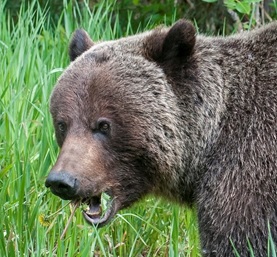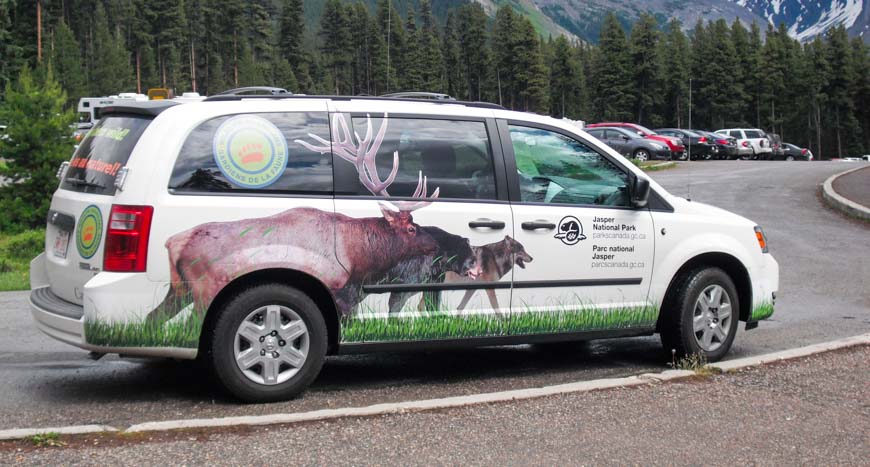
Parks Canada / V. Domaine
Grizzly bear
Jasper National Park
Quick facts
Eats mostly plants; about 150 000 berries a day
Weighs up to 300 kg (Canadian Rocky Mountain populations)
Likes lots of space
Sleeps for 5-7 months every year
Lives 20-30 years
SARA Status: Special Concern (2018)

Grizzly bears (Ursus arctos) are unmistakable because of the large muscular hump on their shoulders. Grizzly bears are scavengers and omnivores, eating both plants and meat. Plants are the mainstay of their diet though, especially berries and roots.
In winter, food becomes scarce and the bears crawl into their dens to hibernate. Although bears do not truly hibernate, (their body temperature only dips slightly), they do become dormant in winter, usually in snow-dens, where females often have one to four cubs before spring.
Grizzly bears have one of the lowest known reproductive rates of all North American land mammals. That rate is even lower for grizzlies living here in the Canadian Rockies. Females have their first cubs at 5-8 years of age, and may not become pregnant again for 4–5 years.
Grizzly bears are particularly sensitive to human influence, and because of this we manage them carefully. We can gain information about the mountain park ecosystem by monitoring the grizzly bear population. Jasper currently supports a population of between 100–120 individuals.
Where they live
Adult female grizzlies cover a 200 to 500 square-kilometre area wandering in search of food. Adult males cover even more ground - up to 4 900 square kilometres. It takes a lot of land to support a self-sustaining population of grizzly bears. Even the combined areas of Banff, Jasper, Yoho and Kootenay national parks do not provide enough habitat on their own for all the bears living in national parks.
Grizzly bears can be seen feeding on dandelions in spring and early summer along park highways and in the valley bottom. They move up into alpine areas in summer. In fall when food is scarce, they can be observed again in the valley bottom.
Best viewing times for most park wildlife is dawn and dusk. Always stay in your car to observe bears by the roadside. Roll down your window to take pictures, quickly move along, and never feed or approach wildlife - including bears.

Why they are at risk
Grizzly bears have a low reproductive rate, and rely on vast areas of uninterrupted habitat to thrive. This makes this species vulnerable to human activities that disturb them in their habitat.
Habitat fragmentation
The continued existence of the grizzly bear depends upon the preservation of large areas of undisturbed wilderness.
Both in and outside of the park, human development and activities like towns, roads and railways can break up the connectivity of their habitat.
Human-caused mortality
Direct human threats to grizzly bears in Jasper National Park include trains, cars and conflicts with people resulting from habituation to people and human food.
How we are helping
Protecting habitat
The mountain national parks provide a large protected area of secure habitat for grizzly bears, where disturbance and habitat fragmentation are minimized.
Essential travel corridors for wildlife are closed to human activity.
Protection from human disturbance
There are reduced speed limits on highways in the national parks for wildlife, as well as prohibitions against harassing wildlife.
At certain times, Parks Canada implements “no stopping” zones that are posted as Important Bulletins.
Resource conservation specialists and Wildlife Guardians are dedicated to managing bears and humans in high human-use areas, especially in spring and summer. Wildlife Guardians patrol park roadways to support safe wildlife viewing by ensuring drivers stay in their vehicles.
Research
Jasper National Park has been collaborating with fRI Research for many years on grizzly bear population monitoring, habitat use and stress hormones.
Parks Canada has also carried out grizzly beargrizzly bear research with other organizations and industry, to better understand grizzly bear habitat use and mortality, and the impacts of human activities on grizzly bears.
Monitoring
Parks Canada monitors bear activity in the park using remote wildlife cameras, VHF ((very high frequency) and GPS (global positioning system) radio and satellite collars, and visual sightings.
We gathered population estimates using DNA from hair snagged at lure stations in 2008 for the northern portion of Jasper National Park, and in 2014 for the southern portion.
We keep detailed records of wildlife incidents in the national park. Data about conflicts between bears and humans helps us prevent them in the future.
Reducing attractants
To prevent bears from becoming habituated to people and human food, we use bear-proof garbage and compost bins in town and at campgrounds, and bear-proof storage lockers for food at backcountry campgrounds.
We periodically remove buffalo berry bushes, a favoured food, from campgrounds, to discourage bears from spending time close to people.
We encourage residents to remove fruit trees from their property or to collect all the fruit in the fall.
Resource conservation specialists remove animals killed on roadways to reduce the number of bears scavenging and spending time near the road.
We work with CN Rail and CP Rail to reduce and remove grain that spills on train tracks.
Education
We teach bear safety to park users, including how to keep a bare campsite with no attractants, how to use bear spray, how to view bears from the road and how to travel safely in bear country.
(The good humans get gold stars.)
We teach bears that are becoming habituated to people to avoid humans instead by using aversive conditioning. Aversive conditioning means creating a negative experience associated with humans. This teaches bears to avoid people and helps them survive.
(The good bears get gold stars.)
Partnering
Parks Canada collaborates with provincial partners to share DNA and telemetry data to monitor grizzly bear populations in the broader Rocky Mountain landscape.
Occasionally, bears are relocated to remove them from conflict situations with people. We work with other national parks and the Provinces of Alberta and British Columbia when bears are moved to the western boundary of Jasper National Park, and monitor any movements into the national park.

Learn more
- Date modified :